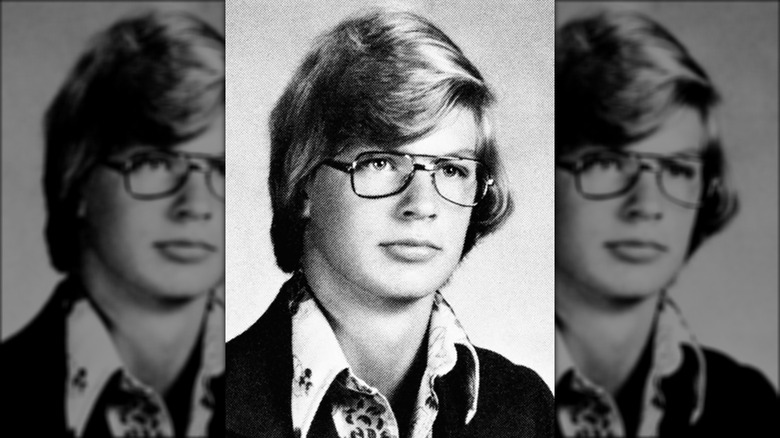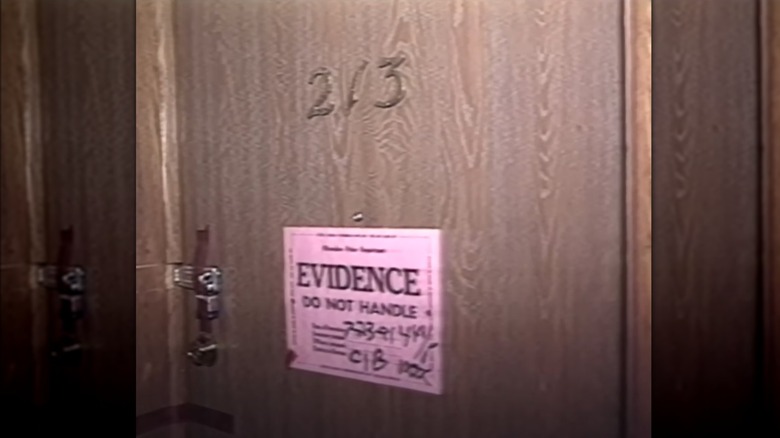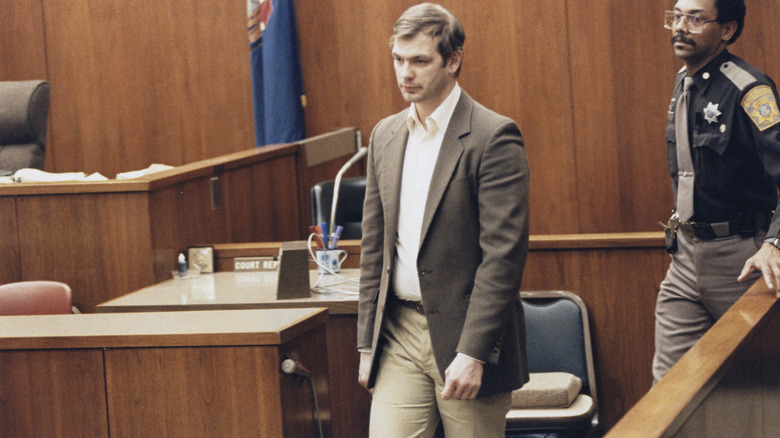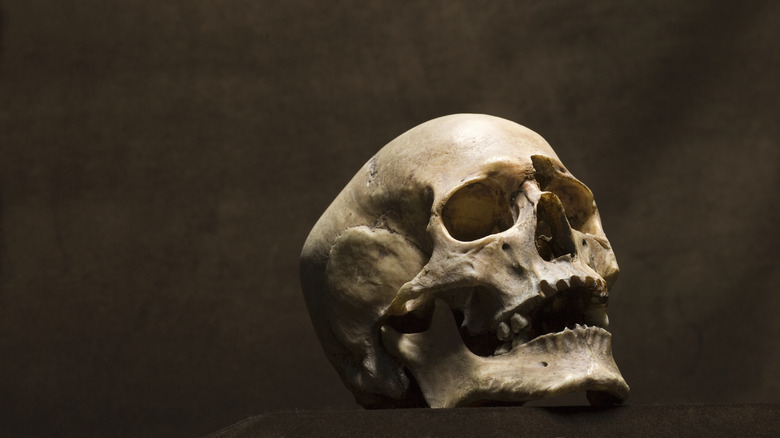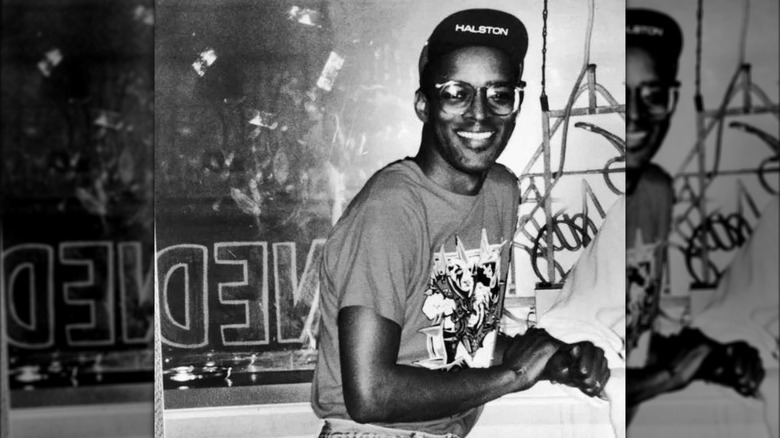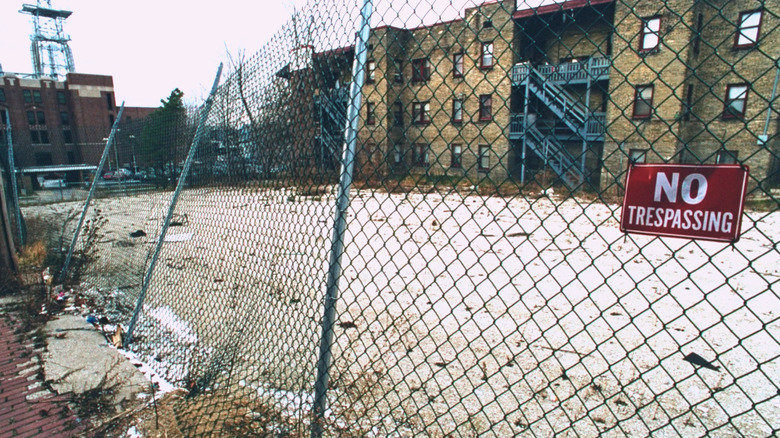What Happened To The Bodies Of Jeffrey Dahmer's Victims
The gory details of a serial killer's murders always give us a gruesome look into the darkest extremes of what a person is capable of, but even among serial killers, there are some that could be described as the worst of the worst. When news broke that the remains of 11 men had been recovered from the apartment of Jeffrey Dahmer, it was shocking stuff ... but that was just the beginning. When more information started to be released about just what he had done to his victims before and after their deaths, it was enough to turn anyone's stomach.
Dr. Jeffrey Jentzen is a Milwaukee County medical examiner and academic with connections to several colleges, including Michigan Tech and the University of Michigan. In an article for the journal Academic Forensic Pathology (via the National Library of Medicine), he wrote that the recovery of the bodies of Dahmer's victims was so bad that it "required a major disaster response [that] continues to influence and affect a community over 25 years later."
It started on July 23, 1991, when Milwaukee police were taken to Dahmer's apartment by a man who had escaped his custody. The first confirmation that something was deeply wrong was the fact that he had a man's head in his refrigerator, and by the time teams had finished going through the apartment, they recovered defleshed bones and skulls, scores of photos, scalps, genitalia, and much, much more. Let's take a closer — and terrible — look at just what happened to Dahmer's victims.
The following article includes graphic descriptions of violence and necrophilia.
The murder of Steven Hicks
Once he was arrested, Jeffrey Dahmer was pretty straightforward about his motivations for killing. The FBI has declassified some of the documents regarding the investigation, including interviews. The list of victims started with Steven Hicks, a hitchhiker who was in the wrong place at the wrong time on a mid-July day in 1978. After he got in the car with the 18-year-old Dahmer (pictured), he was driven back to Dahmer's parents' house, murdered, and became the future serial killer's first experience with necrophilia.
Dahmer went on to say that, after chopping up the remains and putting them in garbage bags, he headed out to dispose of the pieces. That's when he was pulled over by law enforcement, who bought the story that the bags were nothing more than perfectly ordinary garbage. He was issued a traffic ticket, and it was enough to stop Dahmer from killing for the next decade.
Meanwhile, he still had a body to dispose of. Dahmer later explained (via The New York Times) that he initially buried the garbage bags in his backyard, but found himself obsessing over the possibility they would be found. After exhuming the shallow grave, he used a sledgehammer to smash the bones. When law enforcement followed the map and directions he gave them after his arrest, they discovered dozens of bone fragments and hammer marks on the rock that he used. The Summit County Coroner, Dr. William Cox, confirmed, "So far, what he has stated that he did is consistent with what we found."
Victim Number Two: Steven Tuomi
Jeffrey Dahmer waited a long, long time to kill again, and when it did happen, he claimed it was an accident that unfortunately kickstarted the rest of his notorious career. When Dahmer told the FBI about his second victim, he claimed that he'd had no intentions or memory of actually killing Steven Tuomi (pictured). They'd met at a Wisconsin bar, chatted, flirted, and — since Dahmer was living with his grandmother at the time — they headed back to Milwaukee's Ambassador Hotel. Dahmer said that Tuomi was dead when he woke up in the morning, and in order to get the body out of the hotel, he had some unwitting help.
After buying a suitcase and putting Tuomi's body inside, Dahmer called a cab to drive him — and his suitcase — back to his grandmother's home. The driver inquired about the bag, but the questioning didn't go any further.
Once there, he dismembered Tuomi, and — in an MO that would remain pretty consistent throughout his killing career — he dissolved what he could in acid. As he did with Steven Hicks, Dahmer crushed what remained of Tuomi's bones and scattered them. The remains have never been found, and Dahmer cited this incident as reigniting his desire to kill.
Dahmer satisfied his desires by doing specific things to the bodies of his victims
Jeffrey Dahmer's post-arrest interviews make for a chilling glimpse into his psyche, and in FBI interviews, he talked about attempts at satisfying his desires without killing ... at least, as much as he craved. Dahmer said that he found that when he cleaned and kept the skulls of his victims, the bones — and other mementos — would serve to satisfy him until he could kill again. When it came to the fresh bodies, though, there were specific things that he enjoyed, often on a sexual level.
The FBI document is eerie stuff, recording Dahmer's testimony that he enjoyed taking his time with the skin, cutting and peeling it in a way that would allow him to examine blood vessels and capillaries. How on earth did he have the skills to do it? Dahmer explained that he had studied up on it, got tips from taxidermists, and in a famous bit of bizarre judgment, Dahmer had also studied animal anatomy and taxidermy with his father, Lionel Dahmer.
He was also particularly obsessed with the sounds that the corpses made, along with the viscera — the soft internal organs. According to his testimony, "he found [it] sexually arousing to look at the internal organs ... and the way that the internal organs would glisten. Dahmer stated that he had sexual thoughts and fantasies about the viscera." That would ultimately lead to necrophilia, which he facilitated by cutting slits into the lower abdomens of his victims.
They were documented in an extensive Polaroid collection
The need to get 35mm film developed into keepsake photos would have raised red flags pretty quickly, but Polaroids? Those could be taken and developed in the privacy of someone's own home, and that's precisely how Jeffrey Dahmer documented what he did to the bodies of those he murdered. When law enforcement finally started investigating Dahmer's apartment, they very quickly found the drawer that contained dozens of Polaroid photos of his victims, posed in various stages of life, death, and dismemberment. According to the University of Michigan's Department of Pathology expert Jeffrey M. Jentzen, the photos weren't entirely random, in spite of being taken during all stages of Dahmer's drugging and killing of his victims.
Many confirmed that Dahmer had used the large table in his apartment for dissecting victims, and that he'd also used it to pose them, mimicking the pose of a man in a piece of artwork mounted in a prominent place on Dahmer's wall. (In an interview with defense psychologist Judith Becker, Dahmer said (via the Associated Press) that he believed the table gathered and stored his victims' energies.) The work is a 1938 photograph by Raymond Voinquel, a French artist and still photographer who rose to prominence in pre-war Europe as an expert in landscapes and nudes. The photos were among the many souvenirs he kept, and used them to satisfy his desires between kills. (5)
Dahmer developed a method for dismembering and disposing of bodies
Included in his testimonies was Jeffrey Dahmer's admission that in order to kill, he needed to consume copious amounts of alcohol first. That led psychiatrists to explain that it wasn't so much the killing that he was after, but the sexual gratification that came afterwards. That led to the cannibalism and the necrophilia, and in spite of Dahmer's attempts at preserving bodies, it was inevitable they had reached the end of their usefulness to him. Once the killing was done and his desires were fulfilled, there was the need to dispose of the body, and preserve what he wanted to keep and occasionally consume. In an FBI interview, Dahmer explained that he'd developed a method for doing precisely that.
After starting with the removal of the internal organs, Dahmer would then remove flesh — starting with the legs, and working his way up the body — and the head, and in addition to freezing some of the meat for later use and/or consumption, he'd then boil the bones in an 80-gallon cooking pot in order to clean them.
As for getting rid of what he didn't want to keep, Dahmer said that he used hydrochloric muriatic acid, which sounds like it would be tough to get. It's not: It's highly caustic, incredibly dangerous, and widely available at hardware stores. Aside from dissolving a body, it's commonly used in household maintenance and repair projects, including mold removal. Once the pieces were sufficiently dissolved, he would flush them away.
Jeffrey Dahmer confirmed his cannibalistic tendencies
Sometimes, serial killers get elevated into that weird space that exists between history and myth. For example, Ed Gein's collection of human skins and bones came mostly from bodies he'd exhumed, not people he'd killed. (Although he did kill at least two women.) With that in mind, it's possible to see how Jeffrey Dahmer's cannibalism might start to seem like a horrible bit of exaggeration tacked onto an already awful story, but Dahmer has confirmed that, yes, cannibalism was a part of his rituals and desires.
In declassified FBI documents, Dahmer "states that he ate the hearts, liver, thigh meat and at one time he ate a bicep. ... he would prepare this feast by frying the organ in a skillet on the stove, the way you would prepare a regular piece of meat. ... he found the meat to be very tasty ... as eating a filet mignon, which was very tender and juicy."
That's the "what" and the "how," but what about the "why?" Dahmer was pretty consistently straightforward about that, too, telling both the FBI and journalist Nancy Glass that it hadn't been about the taste, but that it was his way of becoming one with his victims, and keeping them with him forever.
Some were the subjects of horrible experiments
Jeffrey Dahmer should have been caught a number of times before he actually was, and one of the most heartbreaking near misses was the shocking incident surrounding 14-year-old Konerak Sinthasomphone. Sinthasomphone managed to escape Dahmer, but — reeling from horrific, unimaginable injuries — ran into police officers who believed Dahmer's claim that they were consensual lovers just going through something of a rough patch. At the time, Sinthasomphone hadn't been able to respond to inquiries — because Dahmer had already drilled a hole through his skull and administered a dose of acid.
That acid was muriatic (hydrochloric) acid, a highly reactive, highly corrosive acid that's widely available, has a slew of practical uses as a heavy-duty cleaner, and is so strong that it can dissolve iron. Sinthasomphone wasn't the only one of Dahmer's victims who was subjected to this gruesome experiment, but ... to what end?
Dahmer later explained his motivations to the FBI, saying that more than killing, he wanted to create a perfectly willing, unconditionally compliant sex zombie who would do whatever he wanted, whenever he wanted, without question, argument, or hesitation. He claimed that drilling into skulls and pouring acid in "worked at first, but after a while the victims would die."
If you or anyone you know has been a victim of sexual assault, help is available. Visit the Rape, Abuse & Incest National Network website or contact RAINN's National Helpline at 1-800-656-HOPE (4673).
The grisly list of body parts recovered from Jeffrey Dahmer's apartment
When it came time for authorities to clear out Jeffrey Dahmer's apartment, it was so bad that protective clothing and breathing equipment were necessary. One of his neighbors, Pamela Bass, spoke with The New York Times and said, "I would hear a buzz saw running in the early evening. I thought he was building something. ... But how could anybody know he was collecting dead bodies? I didn't know what a dead body smells like."
The investigation into the nightmarish house of horrors that was Dahmer's apartment started with the discovery of a head in the refrigerator, and that was just the start. The 55-gallon drum that's featured so famously in crime scene photos actually contained four bodies, while another was discovered in a freezer. In addition to that first refrigerated head, there were also three skulls that had been painted, four non-painted skulls, and four heads that were still mostly intact.
Eerily, the only "food material" recovered was a can of Crisco, along with plastic bags containing what was described as "a human heart and large muscle filets." The list of trophies is just as bad, with authorities cataloging things like dried genitalia, severed hands, and hair. Forensic examination of some of the remains indicated that some wounds had been inflicted on victims while they were still alive, and suggested Dahmer had been experimenting with different-sized drill bits in his attempts to create the perfect sex zombie.
These are the victims identified from remains at his apartment
Everyone's familiar with the names of serial killers, but what about the names of their victims? They're less well-known, so let's talk about Jeffrey Dahmer's victims and how they were identified — even if the FBI files on Dahmer's case make for grisly reading. Let's start with Oliver Lacy, Joseph Bradehoft, and Matt Turner, who were identified by their severed hands, which were among the body parts recovered from Dahmer's apartment. All three were also linked to skeletal remains.
Authorities also recovered various forms of identification from Dahmer's apartment. One of those ID cards belonged to Jeremiah Weinberger, who was later linked to skeletal remains via dental records. A piece of vertebrae was connected to one of the skulls, and dental records allowed for the identification of Anthony Hughes (pictured) — similarly identified was Konerak Sinthasomphone. Dental records also allowed for the identification of skulls belonging to Raymond Lamont Smith, Curtis Straughter, Errol Lindsey, Ernest Miller, and Anthony Sears. (Other body parts — including genitalia and a scalp — were later identified as belonging to Sears.)
Dahmer also confessed to killing Edward Smith, David Thomas, and Richard Guerrero, and FBI files linked to the case confirm that no remains have been recovered from the latter two.
Where were Dahmer's victims finally laid to rest?
Where the final resting places of Jeffrey Dahmer's victims are isn't an easy question to answer, for a few reasons. In addition to some victims never having remains recovered, others were buried privately, with no public information available. And that's pretty understandable, and it's easy to see why families might just want privacy and peace.
Steven Tuomi's body was never recovered, and has an empty grave in a Michigan cemetery. Matt Turner was also buried in Michigan, Steven Hicks has a memorial in Ohio, while Anthony Sears, Konerak Sinthasomphone, Curtis Straughter, and David Thomas are buried in Wisconsin.
Dahmer's apartment building was torn down about a year and a half after his arrest, and it's still an empty lot in spite of proposed plans to turn it into a museum of crime, a study space, and — bizarrely — a childrens' playground. There's also been an ongoing movement to build a memorial to Dahmer's victims, but it's become a surprisingly complicated issue. While it might seem a bit of a no-brainer that creating a memorial would be a good thing, city officials have managed to stall any proposed projects by raising concerns that it would attract the wrong kind of attention. Mayor Cavalier Johnson explained to the Milwaukee Journal Sentinel that although a memorial was warranted, "I am cautious, however, about a physical memorial. That would have an unfortunate potential to attract people who have a morbid fascination with the killer. That is something I would prefer to avoid."

